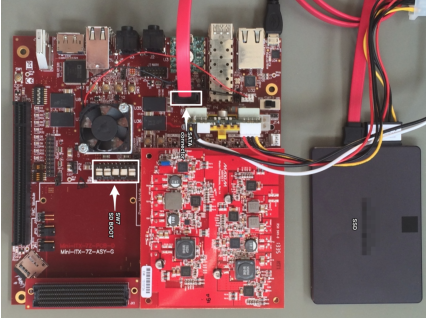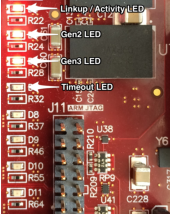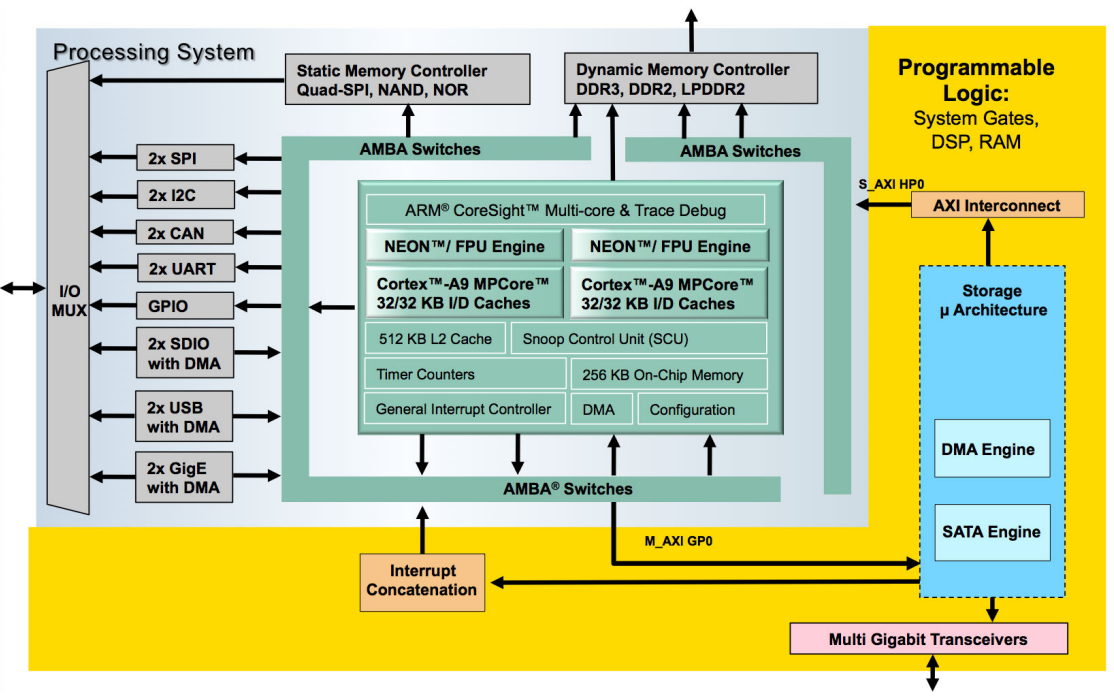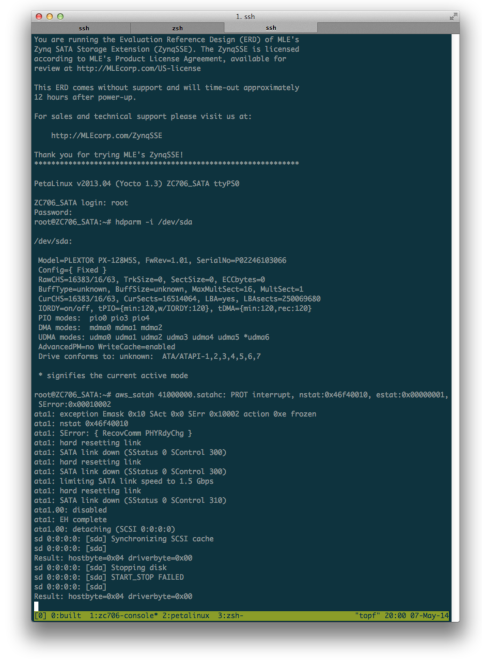ZYNQ SSE for Network-Attached Storage for the Avnet Mini-ITX
This Technical Brief shows how to setup the Zynq SSE to demonstrate NAS functionality. After going through the steps described herein, you will have a working Linux System running on theZynq with an attached SATA HDD or SSD, making files stored on the attached disk available to other networked clients.
Copyright © 2025 Missing Link Electronics. All rights reserved. Missing Link Electronics, the stylized Missing Link Electronics MLE logo are the service mark and/or trademark of Missing Link Electronics, Inc. All other product or service names and trademarks are the property of their respective owners.
For the evaluation of Zynq SSE MLE supports two separate hardware platforms: The Avnet Zynq Mini-ITX board, and the Xilinx ZC706 Development Kit plus the XM104 Adapter Board. This document is for the Avnet Zynq Mini-ITX board.
Network-Attached Storage (NAS) is a file-level data storage connected to a computer network, typically via Ethernet transporting TCP/IP and/or UDP communication.
MLE’s Zynq SATA Storage Extension (Zynq SSE) is a fully integrated and pre-validated system stack comprising 3rd-party SATA Host Controller and DMA IP cores from ASICS World Services, a storage micro-architecture from MLE, Xilinx PetaLinux, and an Open Source SATA Host Controller Linux kernel driver, also from MLE. Zynq SSE utilizes the Xilinx GTX Multi Gigabit Transceivers to deliver SATA I (1.5 Gbps), SATA II (3.0 Gbps), or SATA III (6 Gbps) connectivity. When combined with Zynq’s networking capabilities this effectively leads to a demonstration of Networked Storage, or NAS.
This Technical Brief shows how to setup the Zynq SSE to demonstrate NAS functionality. After going through the steps described herein, you will have a working Linux System running on the Zynq with an attached SATA HDD or SSD, making files stored on the attached disk available to other networked clients.
Block Diagram
The block diagram shown below gives an overview over the Zynq SSE reference design: Within the Zynq Programmable Logic (PL) the MLE storage micro-architecture instantiates the DMA and the SATA Host Controller IP blocks. The storage micro-architecture itself interfaces with the Zynq Processing System (PS) via the high-performance AXI HP0 slave port. The ARM A9 in the PS runs Xilinx PetaLinux and the SATA Linux kernel driver.
Implementation
| Implementation Details | |
|---|---|
| Design Type | PS + PL |
| SW Type | Linux (Petalinux) |
| CPUs | 2 CPUs 700 MHz |
| PS Features | DDR, USB, UART, ETHERNET |
| PL Cores | ASICS.WS SATA IP |
| Boards/Tools | Avnet Mini ITX Z100 |
| Xilinx Tools Version | Vivado 2014.1, PETALINUX 2013-2 |
| Other Details | Samsung 840 SSD(including Cable and Power Supply), SD-Card |
| Address Map | |||
|---|---|---|---|
| Base Address | Size | Interface | |
| SATA IP | 0x41000000 | 4K | S AXI |
| DMA IP | 0x41010000 | 4K | S AXI, M AXI |
| Files Provided | |
|---|---|
| BOOT.bin | Compilation of Bitstream, FSBL and U-Boot |
| Image.ub | Linux Ramdisk Image |
Step by Step Instructions
Hardware needed
- Avnet Mini ITX Z100 Board (including Power supply)

http://www.em.avnet.com/en-us/design/drc/Pages/Xilinx-Zynq-7000-All-Programmable-SoC-Mini-ITX-Development.aspx - Micro USB Cable for USB Console
- Supported SSD (for Example Samsung 840)
- Power Supply for SSD
- Micro SD Card (2 GB or bigger)
- Ethernet Cable to connect Host PC and Avnet ITX board
- PC for UART console
Software Assembly
- Format the SD Card using FAT32 File system
- Put image.ub and BOOT.bin into the root directory of the SD Card
Hardware Assembly
- Insert the SD Card into the Avnet Mini ITX board’s SD Slot
- Connect the micro USB cable to the UART port of the Avnet Mini ITX board and the USB Port of your PC
- Connect the Ethernet port of the host pc to the ethernet port of the Avnet Mini ITX
- Connect the SSD to the SATA connector on the Avnet Mini ITX board using the SATA Cable
- Connect the SSD to power
- Switch the Avnet Mini ITX board’s SW7 to SD Boot mode (as shown in picture)
- Connect the Avnet Mini ITX board to the Power Supply
The system should now look like in the supplied image
Startup
- Switch on the Avnet Mini ITX board
- On the PC open a Serial Terminal on the new serial port using the settings 115200 Baud 8N1
- Observe the Linux System booting
- After some time you should see a screen similar to the screenshot in the Expected Results
- Login using
- Login:root
- Password: root
- Configure the Ethernet port on the host PC to have an IP address of 10.89.231.1 and a subnet mask of 255.255.255.0
- The ZYNQ-board has an pre-supplied IP of 10.89.231.200
- Now connect to the ZYNQ-board using an FTP program and start transferring data to it
LED Description
Status LEDs can be found next to the PCIe connector. The associated meanings can be seen in the following table and in the image below.

| D7 | Timeout LED, indicates the Timeout of the IP core |
| D6 | Gen3 Link, indicates 6 GBit/s connection |
| D5 | GEN2 Link, indicate 3 GBit/s connection |
| D4 | Linkup and Activity, LED will light up on Linkup and will go dark during data transfers |
Expected Results
As a result you should be having a running Linux system on the Zynq board. The UART Console output should be similar to the screenshot below.
Also you will have file-system access to the attached SSD using FTP, and by this evaluate and test the Zynq Sata Storage extension.
The Evaluation Reference Design (ERD) of the Zynq SSE comprises a hardware license management which allows to run full SATA functionality for up to 12 hours after power-up. After approximately 12 hours the evaluation expires, which is indicated by illuminating the LED ’timeout’. You will also notice that the Linux kernel driver informs you of having lost the SATA link to the SSD/HDD.
Team MLE has spent significant efforts to try and test all aspects of Zynq SSE. If you feel that you encounter something not right, or if you do have any questions, please do not hesitate to contact us.
🌐 www.missinglinkelectronics.com
MLE (Missing Link Electronics) is offering technologies and solutions for Domain-Specific Architectures, which focus on heterogeneous computing using FPGAs. MLE is headquartered in Silicon Valley with offices in Neu-Ulm and Berlin, Germany.


